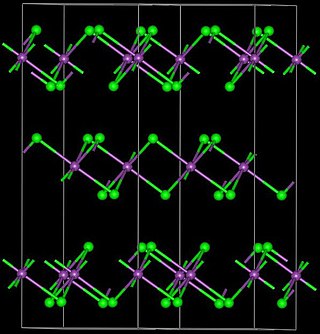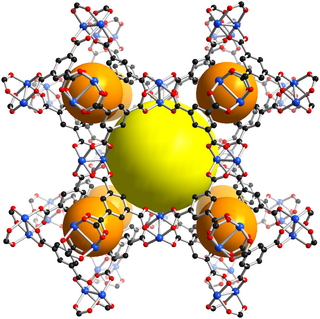Related Research Articles

Silver cyanide is the chemical compound with the formula AgCN. It is a white solid that precipitated upon treatment of solutions containing Ag+ with cyanide, which is used in some schemes to recover silver from solution. Silver cyanide is used in silver-plating.

Yttrium(III) bromide is an inorganic compound with the chemical formula YBr3. It is a white solid. Anhydrous yttrium(III) bromide can be produced by reacting yttrium oxide or yttrium(III) bromide hydrate and ammonium bromide. The reaction proceeds via the intermediate (NH4)3YBr6. Another method is to react yttrium carbide (YC2) and elemental bromine. Yttrium(III) bromide can be reduced by yttrium metal to YBr or Y2Br3. It can react with osmium to produce Y4Br4Os.

Dimanganese decacarbonyl, which has the chemical formula Mn2(CO)10, is a binary bimetallic carbonyl complex centered around the first row transition metal manganese. The first reported synthesis of Mn2(CO)10 was in 1954 at Linde Air Products Company and was performed by Brimm, Lynch, and Sesny. Their hypothesis about, and synthesis of, dimanganese decacarbonyl was fundamentally guided by the previously known dirhenium decacarbonyl (Re2(CO)10), the heavy atom analogue of Mn2(CO)10. Since its first synthesis, Mn2(CO)10 has been use sparingly as a reagent in the synthesis of other chemical species, but has found the most use as a simple system on which to study fundamental chemical and physical phenomena, most notably, the metal-metal bond. Dimanganese decacarbonyl is also used as a classic example to reinforce fundamental topics in organometallic chemistry like d-electron count, the 18-electron rule, oxidation state, valency, and the isolobal analogy.

The Liebeskind–Srogl coupling reaction is an organic reaction forming a new carbon–carbon bond from a thioester and a boronic acid using a metal catalyst. It is a cross-coupling reaction. This reaction was invented by and named after Jiri Srogl from the Academy of Sciences, Czech Republic, and Lanny S. Liebeskind from Emory University, Atlanta, Georgia, USA. There are three generations of this reaction, with the first generation shown below. The original transformation used catalytic Pd(0), TFP = tris(2-furyl)phosphine as an additional ligand and stoichiometric CuTC = copper(I) thiophene-2-carboxylate as a co-metal catalyst. The overall reaction scheme is shown below.

Copper hydride is inorganic compound with the chemical formula CuHn where n ~ 0.95. It is a red solid, rarely isolated as a pure composition, that decomposes to the elements. Copper hydride is mainly produced as a reducing agent in organic synthesis and as a precursor to various catalysts.
Gregory S. Girolami is the William H. and Janet G. Lycan Professor of Chemistry at the University of Illinois at Urbana-Champaign. His research focuses on the synthesis, properties, and reactivity of new inorganic, organometallic, and solid state species. Girolami has been elected a fellow of the American Association for the Advancement of Science, the Royal Society of Chemistry, and the American Chemical Society.

Jillian Lee Dempsey is an American inorganic chemist and the Bowman and Gordon Gray Distinguished Term Professor at the University of North Carolina at Chapel Hill. Currently, her work focuses on proton-coupled electron transfer, charge transfer events, and quantum dots. She is the recipient of numerous awards for rising stars of chemistry, including most recently a 2016 Alfred P. Sloan Research Fellowship and a 2016 Air Force's Young Investigator Research Program (YIP).
Parisa Mehrkhodavandi is a Canadian chemist and Professor of Chemistry at the University of British Columbia (UBC). Her research focuses on the design of new catalysts that can effect polymerization of sustainably sourced or biodegradable polymers.
Lawrence Que Jr. is a chemist who specializes in bioinorganic chemistry and is a Regents Professor at the University of Minnesota, Twin Cities. He received the 2017 American Chemical Society (ACS) Award in Inorganic Chemistry for his contributions to the field., and the 2008 ACS Alfred Bader Award in Bioinorganic Chemistry.

Phosphenium ions, not to be confused with phosphonium or phosphirenium, are divalent cations of phosphorus of the form [PR2]+. Phosphenium ions have long been proposed as reaction intermediates.
Jenny Yue-fon Yang is an American chemist. She is an associate professor of chemistry at the University of California, Irvine where she leads a research group focused on inorganic chemistry, catalysis, and solar fuels.
Jeffrey R. Long is a professor of Chemistry at University of California, Berkeley known for his work in metal−organic frameworks and molecular magnetism. He was elected to the American Academy of Arts and Sciences in 2019 and is the 2019 F. Albert Cotton Award recipient. His research interests include: synthesis of inorganic clusters and porous materials, investigating the electronic and magnetic properties of inorganic materials; metal-organic frameworks, and gas storage/capture.
Julia A. Kovacs is an American chemist specializing in bioinorganic chemistry. She is Professor of Chemistry at the University of Washington. Her research involves synthesizing small-molecule mimics of the active sites of metalloproteins, in order to investigate how cysteinates influence the function of non-heme iron enzymes, and the mechanism of the oxygen-evolving complex (OEC).

HKUST-1, which is also called MOF-199, is a material in the class of metal-organic frameworks (MOFs). Metal-organic frameworks are crystalline materials, in which metals are linked by ligands to form repeating coordination motives extending in three dimensions. The HKUST-1 framework is built up of dimeric metal units, which are connected by benzene-1,3,5-tricarboxylate linker molecules. The paddlewheel unit is the commonly used structural motif to describe the coordination environment of the metal centers and also called secondary building unit (SBU) of the HKUST-1 structure. The paddlewheel is built up of four benzene-1,3,5-tricarboxylate linkers molecules, which bridge two metal centers. One water molecules is coordinated to each of the two metal centers at the axial position of the paddlewheel unit in the hydrated state, which is usually found if the material is handled in air. After an activation process, these water molecules can be removed and the coordination site at the metal atoms is left unoccupied. This unoccupied coordination site is called coordinatively unsaturated site (CUS) and can be accessed by other molecules.
Devon Walter Meek (1936–1988) was an American chemist and professor at Ohio State University.
The borate iodides are mixed anion compounds that contain both borate and iodide anions. They are in the borate halide family of compounds which also includes borate fluorides, borate chlorides, and borate bromides.
Jonas C. Peters is the Bren Professor of Chemistry at the California Institute of Technology and Director of the Resnick Sustainability Institute. He has contributed to the development of catalysts and photocatalysts relevant to small molecule activation.
Karsten Meyer is a German inorganic chemist and Chair of Inorganic and General Chemistry at the Friedrich-Alexander University of Erlangen-Nürnberg (FAU). His research involves the coordination chemistry of transition metals as well as uranium coordination chemistry, small molecule activation with these coordination complexes, and the synthesis of new chelating ligands. He is the 2017 recipient of the Elhuyar-Goldschmidt Award of the Spanish Royal Society of Chemistry, the Ludwig-Mond Award of the Royal Society of Chemistry, and the L.A. Chugaev Commemorative Medal of the Russian Academy of Sciences, among other awards. He also serves as an Associate Editor of the journal Organometallics since 2014.
Connie C. Lu is a Taiwanese-American inorganic chemist who is a Professor of Chemistry at the University of Minnesota, Twin Cities. Lu's research focuses on the synthesis of novel bimetallic coordination complexes, as well as metal-organic frameworks. These molecules and materials are investigated for the catalytic conversion of small molecules like as N2 and CO2 into value-added chemicals like ammonia and methanol. Lu is the recipient of multiple awards for her research, including the National Science Foundation CAREER Award and the Sloan Research Fellowship in 2013, and an Early Career Award from the University of Minnesota's Initiative for Renewable Energy and the Environment in 2010.

The oxalate phosphates are chemical compounds containing oxalate and phosphate anions. They are also called oxalatophosphates or phosphate oxalates. Some oxalate-phosphate minerals found in bat guano deposits are known. Oxalate phosphates can form metal organic framework compounds.
References
- ↑ "Karen Williams Morse - Denison University Alumni". 2020-09-25. Archived from the original on 2020-09-25. Retrieved 2022-04-10.
- ↑ MORSE, KAREN DALE WILLIAMS (1967). Reactions of the borane group as a Lewis acid (Thesis). OCLC 68277057.
- 1 2 3 University, Utah State (2007-11-15). "Former USU Provost Karen Morse Announces Retirement in Washington". Utah State Today. Retrieved 2022-04-10.
- 1 2 University, Utah State (2021-04-27). "Three Individuals to Receive Honorary Degrees at USU's 134th Commencement". Utah State Today. Retrieved 2022-04-10.
- ↑ House, Dawn (1989-06-28). "Dean at USU is state's first woman provost". The Salt Lake Tribune. p. 20. Retrieved 2022-04-10.
- ↑ "Karen W. Morse Institute". BBJ Today. Vol. 22, no. 12. December 2014 – via Gale.
- ↑ Morse, Karen W.; Morse, Joseph G. (1973). "Free radical reactions of tetrafluorodiphosphine. Preparation of 1,2-bis(difluorophosphino)ethane". Journal of the American Chemical Society. 95 (25): 8469–8470. doi:10.1021/ja00806a057. ISSN 0002-7863.
- ↑ Morse, Karen W.; Parry, Robert W. (1967). "The Basic Properties of Tetrafluorodiphosphine. The Synthesis of Tetrafluorodiphosphine Borane". Journal of the American Chemical Society. 89 (1): 172–173. doi:10.1021/ja00977a049. ISSN 0002-7863.
- ↑ Bommer, Jerry C.; Morse, Karen W. (1977). "[(MePh 2 P) 3 CuBH 4 ]: a single M–H bridged tetrahydroborate". J. Chem. Soc., Chem. Commun. (5): 137–138. doi:10.1039/C39770000137. ISSN 0022-4936.
- ↑ Bommer, Jerry C.; Morse, Karen W. (1980). "Single hydrogen-boron bridged species: tris(methyldiphenylphosphine) complexes of silver(I) and copper(I) containing tetrahydroborate and (ethoxycarbonyl)trihydroborate". Inorganic Chemistry. 19 (3): 587–593. doi:10.1021/ic50205a003. ISSN 0020-1669.
- ↑ Bommer, Jerry C.; Morse, Karen W. (1983). "Phosphite complexes of copper(I) containing chloride, tetrahydroborate, and (ethoxycarbonyl)trihydroborate". Inorganic Chemistry. 22 (4): 592–596. doi:10.1021/ic00146a005. ISSN 0020-1669.
- ↑ Fife, Dennis J.; Moore, William M.; Morse, Karen W. (1984). "Solution equilibria of tertiary phosphine complexes of copper(I) halides". Inorganic Chemistry. 23 (12): 1684–1691. doi:10.1021/ic00180a011. ISSN 0020-1669.
- ↑ Fife, Dennis J.; Moore, William M.; Morse, Karen W. (1985). "Photosensitized isomerization of norbornadiene to quadricyclane with (arylphosphine)copper(I) halides". Journal of the American Chemical Society. 107 (24): 7077–7083. doi:10.1021/ja00310a053. ISSN 0002-7863.
- ↑ Fife, Dennis J.; Morse, Karen W.; Moore, William M. (1984). "Electronic transitions of aryl phosphines". Journal of Photochemistry. 24 (3): 249–263. doi:10.1016/0047-2670(84)87004-5.
- ↑ Morse, Karen W. (1992-04-13). "ACS COMMENT: Degree options for ACS certification". Chemical & Engineering News Archive. 70 (15): 67. doi: 10.1021/cen-v070n015.p067 . ISSN 0009-2347.
- ↑ Morse, Karen W. (1992-11-23). "ACS COMMENT: CPT and Education Challenges". Chemical & Engineering News Archive. 70 (47): 28. doi:10.1021/cen-v070n047.p028. ISSN 0009-2347.
- ↑ "Historic Fellows | American Association for the Advancement of Science". www.aaas.org. Retrieved 2022-04-10.
- ↑ "Francis P. Garvan-John M. Olin Medal Recipients". American Chemical Society. Retrieved 2022-04-10.
- ↑ "Chemistry Building renamed for Karen Morse | Western Today | Western Washington University". westerntoday.wwu.edu. December 17, 2012. Retrieved 2022-04-10.